Puvunga
Puvunga (alternate spellings: Puvungna or Povuu'nga) is an ancient village and sacred site of the Tongva nation, the Indigenous people of the Los Angeles Basin, and the Acjachemen, the Indigenous people of Orange County. The site is now located within California State University, Long Beach and the surrounding area.[1] The Tongva know Puvunga as the "place of emergence" and it is where they believed "their world and their lives began."[2] Puvunga is an important ceremonial site and is the end to an annual pilgrimage for the Tongva, Acjachemen, and Chumash.[1]
Puvunga Indian Village Sites and Boundary Increase | |
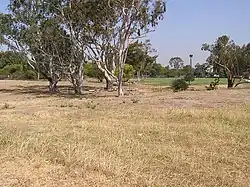 The Puvunga site on the campus of Cal State Long Beach | |
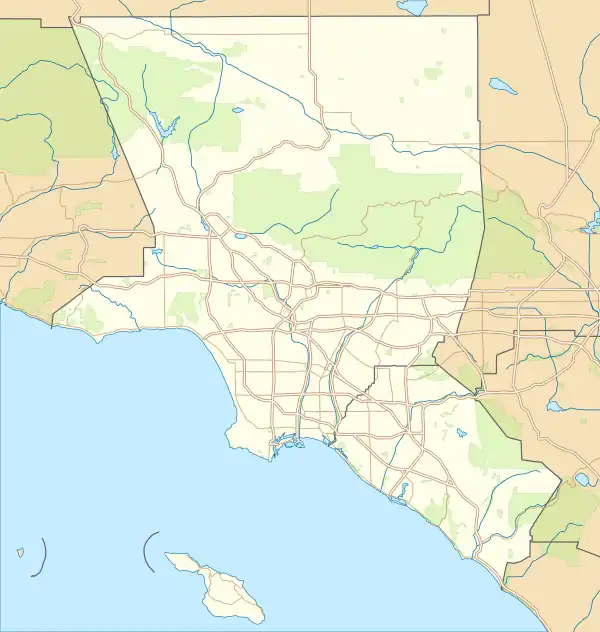   | |
| Nearest city | Long Beach, California |
|---|---|
| Coordinates | 33.785°N 118.121°W |
| Architect | Tongva |
| NRHP reference No. | 74000521 (original) 82000429 (increase) |
| Significant dates | |
| Added to NRHP | January 21, 1974 |
| Boundary increase | May 22, 1982 |
Before the arrival of European settlers, Puvunga extended far beyond the contemporary location or site that remains.[1] Its presence was first uncovered in 1952, and then in 1974, at the designated location, when trenching was done for the Earl Burns Miller Japanese Garden. The site was listed on the National Register of Historic Places.[1] In 1992, the university challenged its historic designation and threatened force to build a strip mall on the site, which was blocked by direct action and intervention by the ACLU.[1] In 2019, dirt and trash were dumped on the site by the university.[3]
The site is located near the Japanese Garden along the banks of a now channelized creek, about three miles (5 km) from the Pacific Ocean.[1] The site is not marked with a sign or other informational marker on its significance. It remains a natural area located near a parking lot at the edge of campus.[1] There was a natural spring located a short distance from the Rancho Alamitos building that flowed until 1956 referred to as Puvunga Spring.[4] Another similar (but larger) Tongva site is Kuruvungna Springs on the grounds of University High School in Los Angeles.
Etymology
Puvunga can mean "the place of the gathering" or "in the ball," depending on the source.[1]
Significance
The site has been listed on the National Register of Historic Places since 1974 for its historical and cultural significance. It remains a ceremonial site for the Acjachemen, Tongva, and Chumash for intertribal gatherings and as the ending of an annual pilgrimage that begins at the village site of Panhe, now located in San Onofre.[1]
The Tongva and Acjachemen remember the village as home to Wiyot, one of the First Beings who was their sacred leader.[5] It is "the place of emergence" or where "their world and their lives began."[2] In Tongva traditional narratives, it is also, a few centuries later, the birthplace of Chingishnish, "the prophet or deity who appears at Puvunga after Wiyot, the creator, has been killed, and tells the assembly what they must do to feed themselves."[6]
Rare bird species have been identified on the site by the Audubon Society.[1]
History
Prosperous village
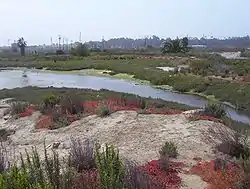
Puvunga once stood on a rounded knoll or small hill above the expansive wetlands, now known as the Los Cerritos Wetlands, of the San Gabriel River. The Pacific Ocean, now pushed several miles west by settlers and commercial development, came to the bluff of the village.[5]
Puvunga was a large village that extended far beyond the remaining area associated with the village. It was a major regional trading and ceremonial center for the Tongva and Acjachemen. Villagers used te'aats to travel out to villages on Pimu (Santa Catalina Island) and other islands off the coast, now referred to as the Channel Islands, a journey of cultural importance.[5]
Nearby coastal villages included the very close settlement of Motuucheyngna (Seal Beach),[8] now sometimes referred to in archaeological terms as Puvungna East,[7] Guashna (now at Playa Vista) located about twenty miles up the coast,[5] and the village of Lupukngna, located down the coastline at the mouth of the Santa Ana River.[2]
Colonization
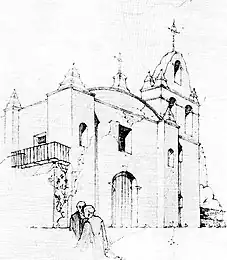
Like many other Tongva villages in the greater Los Angeles Basin area, village life at Puvunga deteriorated immensely with the arrival of Spanish missionaries and soldiers.[10]
With the establishment of Mission San Gabriel in 1771,[9] many people from surrounding villages were brought to the mission for conversion and as a labor force to work the grounds of the mission in conditions that were recognized as slavery by third-party observers at the time.[11] Between 1785 and 1805, mission records noted numerous baptisms of villagers from Puvunga, indicating that the village was likely depleted shortly after.[10]
In 1822, Geronimo Boscana referred to the village as Pubuna and located it within the Spanish land grant Rancho de los Nietos established in 1784, which was eight leagues northwest of Mission San Juan Capistrano.[12]
Many villagers likely died at the mission and many did not survive the mission period.[10] At Mission San Gabriel, there were a total of 7,854 baptisms (2,459 children) and 5,656 deaths (2,916 children) until secularization in 1834, indicating a very high rate of death.[13] Children often died very young at the missions. One missionary at Mission San Gabriel reported that three out of every four children born died before age two.[14]
In 1844, Hugo Reid referred to the village as Pubugna and stated it could still be identified as existing at Rancho Los Alamitos, which was a subdivision of Rancho de los Nietos.[12]
John Peabody Harrington identified the presence of shell middens in the Rancho Los Alamitos area. At this time, Harrington consulted three Indigenous informants, Jose de Los Santos Juncos, José de Grácia Cruz, and a "very old informant" Guorojos, who each referred to the site as the village, referred to as Puvu'na and Puvu, as being in Los Alamitos. Harrington's report of these events was published in 1933.[12]
1952 excavation
The first awareness of the village's presence to most Long Beach residents occurred in 1952. On Christmas Eve of that year, a burial site of Puvunga was discovered about a mile north of the California State University, Long Beach campus, then referred to as Long Beach State College when workers of the L. S. Whaley Company uncovered two dozen ancestral remains and funerary objects in the construction of a housing development. In 1952, an article for the Long Beach Press-Telegram wrote that the "ruins might be part of Pubunga an ancient 'holy city.'"[1]
In 1955, it was noted by Helen Smith Giffen that there were "shell debris littering the fields below the [Los Alamitos] ranch house bear witness to the fact that this was once the site of an Indian rancheria [Puvunga]." She noted that there was still a "wonderful spring" which flowed at the location.[15]
1974 historic designation
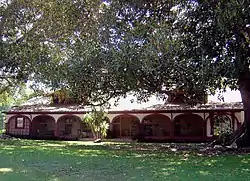
In 1972, campus workmen uncovered portions of a burial at LAn-235 on the western edge of campus. Funding for the 1973 excavation was provided by the City of Long Beach, Long Beach Historical Society, Rancho Los Alamitos Associates, and private donors. Tongva remnants unearthed included arrowheads and pottery shards in a style called Cerritos Brown ware.[16] These remains were placed in CSULB's archaeology lab.
Archaeologists in 1974 wrote that the Tongva “abruptly abandoned the site in the early 1800s, only a year or so before the first white family took possession of the land.”[16] More than a dozen archaeological sites spread over an area of about 500 acres (2.0 km2) on and near the campus have been identified as Puvungna village sites. A shopping center and apartments at 7th Street and Pacific Coast Highway, Long Beach Veterans Administration Hospital, Rancho Los Alamitos and the college now stand atop the historic settlement “near the present-day mouth of the San Gabriel River and the Cerritos Channel.”[16]
In 1974, LAn-235 was placed on the National Register of Historic Places to represent Puvungna "as a means of perpetuating the memory of these native peoples and their religion, and as an aid to the program of public education."[17] Two other sites were included in the National Register: the adjacent LAn-234 and LAn-306, located just east of campus on the grounds of the historic Rancho Los Alamitos.[1][18]
In 1979, a reburial of an individual disinterred in 1972 occurred. After this reburial, campus workmen erected a small engraved wooden sign at the site, which read "Gabrieleno Indians once inhabited this site, Puvunga, the birthplace of Chungicnish, law-giver and god."[1]
1992 strip mall threat
Despite its known importance, in 1992, the university attempted to challenge Puvunga's designation as a historic site to construct a strip mall on the remaining site of Puvunga as well as a nearby organic community garden that had been established on the first Earth Day. When gardeners organized to prevent a parking lot development for the strip mall site, campus officials ignored them. They moved forward with development, claiming that "no cultural resources" were on site.[17]
In response, the Tongva and others organized to stop the development to save the site from destruction. They initiated protests and filed a lawsuit that temporarily stalled any construction.[17] The university's sudden hostile attitude toward the preservation of the site has been credited to a change in the university's leadership and the decline in California state support for public education,[1] which has pushed universities to find economic revenue sources "to replace state support for higher education that has drastically eroded in the last two decades."[5]
As a result, direct action was initiated to prevent the site's development. Tents were pitched, and a prayer vigil was performed. In response, the university built a fence around the area and ordered that they leave the site with the threat of arrest. This prompted the American Civil Liberties Union (ACLU) to get involved who filed a preliminary injunction against the university. Raleigh Levine of the ACLU stated: "This case is about the First Amendment rights of the Native Americans to whom Puvungna is sacred. They have the right to freely exercise their beliefs without the state stepping in to pave over their place of worship and put a mini-mall on it."[17]
A short film of the event, "Sacred Lands, White Man's Laws" was made available in 1994.[17]
2000 burial disturbance
A burial site in the greater Puvunga area was disturbed in the construction of the neighborhood of Hellman Ranch in the adjacent city of Seal Beach. The site is sometimes archaeologically referred to as Puvungna East or as the village of Motuucheyngna, because of its proximity to Puvugna and in acknowledgment of the large area the village once comprised. About 35 bodies were disturbed in the development of Hellman Ranch, along with numerous artifacts of the Tongva.[7]
2019 dumping
In 2019, CSULB received backlash after dumping dirt and trash on the site.[3] Local self-identified Indigenous groups, such as the Juaneño Band of Mission Indians, Acjachemen Nation were not consulted in regard to the dumping. This resulted in a legal challenge by the tribe which halted the dumping in October 2019. However, the legal proceedings were stalled due to the COVID-19 pandemic and CSULB had yet to remove the dirt and trash by May 2020. Chairman of the tribe Matias Belardes commented on how the dumping reflected a shift in attitude from the university since the 1992 lawsuit:[19]
We’ve had a decent relationship since then [the 1992 incident when CSULB attempted to build a strip mall on the site] ... [We] find it disrespectful and disheartening. Ever since that lawsuit, it was thought that there would be a better understanding of what that site means to us. Somewhere along the way, there’s been a disconnect. Now we’re back to square one after all these positive things from the original lawsuit all those years ago. We thought we were past it already. It shouldn’t have come to this. The university should know the site's significance, what it means to the tribes, and what you can and can’t do on the property.[19]
In response, six departments at CSULB are developing film and educational resources to teach the campus community about the significance of the site in an attempt to prevent future damage.[20]
See also
References
- Loewe, Ronald (2016). Of sacred lands and strip malls : the battle for Puvungna. Lanham, MD. pp. 1–3. ISBN 978-0-7591-2162-1. OCLC 950751182.
{{cite book}}: CS1 maint: location missing publisher (link) - Greene, Sean; Curwen, Thomas (May 9, 2019). "Mapping the Tongva villages of L.A.'s past". Los Angeles Times. Retrieved June 19, 2019.
- Jordan, Rachel (October 5, 2019). "CSULB under fire for dumping dirt, trash on sacred Native American grounds". Abc7 Los Angeles.
- Woodbrige, Sally; Berner, Loretta; Young, Pamela. "Architectural Narrative: "Rancho Los Alamitos"" (PDF). Rancho los Alamitos: 2.
- Lepowsky, Maria (2012). The restless anthropologist : new fieldsites, new visions. Chicago: The University of Chicago Press. pp. 60–61. ISBN 978-0-226-30497-7. OCLC 780446639.
- Loewe, Ronald (2016). Of Sacred Lands and Strip Malls: The Battle for Puvungna. Rowman & Littlefield. p. 26. ISBN 9780759121607.
- "Tribal Cultural Landscape" (PDF). Tribal Cultural Resources: 7. May 2020.
- Lewinnek, Elaine (2022). A people's guide to Orange County. Gustavo Arellano, Thuy Vo Dang. Oakland, California. p. 190. ISBN 978-0-520-97155-4. OCLC 1226813397.
{{cite book}}: CS1 maint: location missing publisher (link) - Society, California Historical (1966). California Historical Society Quarterly. California Historical Society. pp. 21–23.
- The Masterkey for Indian Lore and History. Southwest Museum. 1972. pp. 85–87.
- Street, Richard Steven (2004). Beasts of the Field: A Narrative History of California Farmworkers, 1769-1913. Stanford University Press. p. 39. ISBN 9780804738804.
a clerk with the Jedediah Smith fur-trapping party spent considerable time observing his San Gabriel mission surroundings. He soon found himself unable to tolerate the site of the natives working in the nearby vineyards and fields. 'They are kept in great fear, and for the least offense they are corrected,' he confided in his diary. 'They are... complete slaves in every sense of the word.'
- Loewe, Ronald (2016). Of sacred lands and strip malls : the battle for Puvungna. Lanham, MD. pp. 117–118. ISBN 978-0-7591-2162-1. OCLC 950751182.
{{cite book}}: CS1 maint: location missing publisher (link) - Guinn, James Miller (1907). History of the State of California and Biographical Record to Oakland and Environs: Also Containing Biographies of Well-known Citizens of the Past and Present (Digitized eBook). Historic Record Company. pp. 56–66.
- Singleton, Heather Valdez (2004). "Surviving Urbanization: The Gabrieleno, 1850–1928". Wíčazo Ša Review. 19 (2): 49–59. doi:10.1353/wic.2004.0026. JSTOR 1409498. S2CID 161847670 – via JSTOR.
- Giffen, Helen Smith (1955). Casas & Courtyards: Historic Adobe Houses of California. Biobooks. p. 77.
- Getze, Goerge. "PUVUNGNA PARTIALLY EXCAVATED: INDIAN HOLY VILLAGE UNCOVERED ARCHAEOLOGISTS BEGIN DIG ON INDIAN VILLAGE." Los Angeles Times (1923-1995), Apr 08, 1974, pp. 2-oc_a1.
- "Puvungna 1996". home.csulb.edu. Retrieved December 24, 2022.
- "National Register of Historical Places - CALIFORNIA (CA), Los Angeles County". www.nationalregisterofhistoricplaces.com. Retrieved August 17, 2022.
- Kazenoff, Tess; Gomez, Savannah (May 25, 2020). "CSULB dumping on Native American burial site". LBCC Viking News.
- In and out of view : art and the dynamics of circulation, suppression, and censorship. Catha Paquette, Karen L. Kleinfelder, Christopher Miles. New York. 2022. p. 226. ISBN 978-1-5013-5871-5. OCLC 1200832053.
{{cite book}}: CS1 maint: location missing publisher (link) CS1 maint: others (link)
External links
- The California Cultural Resources Preservation Alliance Inc. (CCRPA)
- Puvungna web page maintained by Prof. Eugene Ruyle
- CSULB 49er article on Puvunga (February 2006)
- "Native American tribes continue to fight to protect parcel of land on CSULB campus" (2020)


